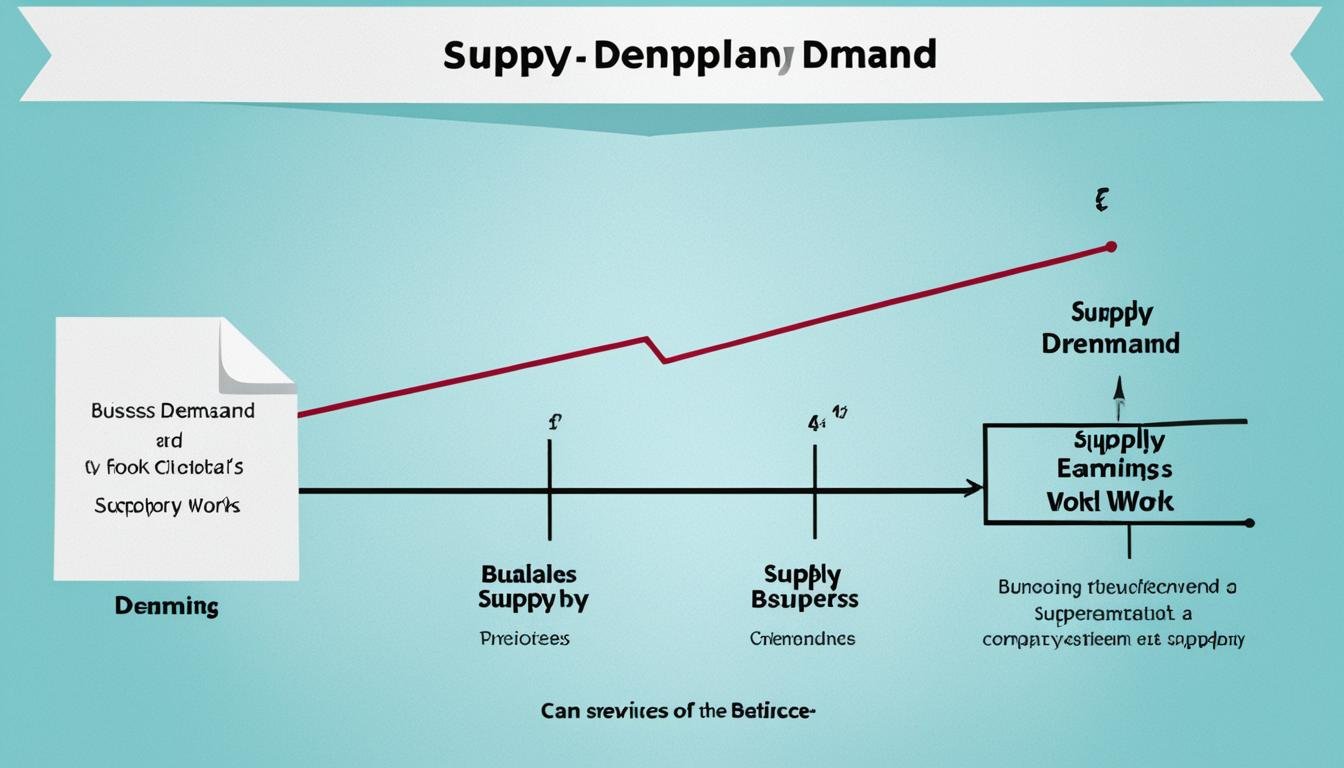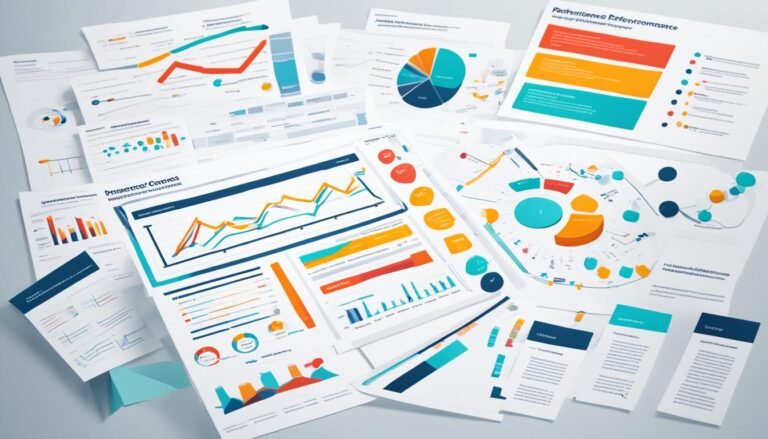How do supply and demand dynamics affect business management?
Did you know 85% of businesses point to supply and demand analysis as vital? The ins and outs of supply and demand are crucial for smart business decisions. Analyzing market trends and forming solid strategies help businesses succeed in a challenging market.
This article dives into how supply and demand affect business management. We’ll look at everything from managing inventory to setting prices. Plus, we’ll see how these dynamics influence product creation and market reaction.
Key Takeaways:
- Supply and demand analysis is crucial for businesses to make informed decisions.
- Understanding market trends and forces helps businesses stay competitive.
- Optimizing pricing strategies based on supply and demand dynamics maximizes profitability.
- Supply and demand impact inventory management and customer care.
- Strong demand attracts financing and investment opportunities.
The Role of Supply and Demand in Inventory Management
Supply and demand are vital in keeping business inventories in check. By looking at these curves, companies can figure out how much stock they need. This ensures they meet customer demand without overspending. Having the right amount of stock also keeps customers coming back.
Finding the perfect balance can be tough. Too much stock can waste money and space. But, too little can mean lost sales and unhappy customers. The goal is to keep stock levels just right to match what people want to buy.
Market equilibrium is when what customers want matches what businesses have. This matching game is a win for everyone. It means customers can find what they need, and companies aren’t wasting resources. With things in balance, companies do better financially and can make their customers happier.
The Impact of Supply Chain Management
Just looking at supply and demand isn’t enough. A strong supply chain is also key in keeping inventory on track. It ensures goods flow smoothly from where they’re made to where they’re sold.
A good chain lets businesses see when demand might spike and get ready. For example, before a busy shopping season, a store might work with its suppliers to get more items. This keeps operations running smoothly when everyone is buying more.
Having an efficient chain also means saving money and being quick to respond. Better chains mean less time and cost getting goods where they need to go. This keeps inventory costs down and helps companies sell more, no matter what the market is doing.
Benefits of Effective Inventory Management
Getting inventory management right has many pluses for companies. It keeps customers happy, saves money, and makes operations run more smoothly.
- It helps companies avoid letting down their customers. With the right stock, they can fill orders fast without running out.
- It means businesses don’t spend too much on storage or on goods they can’t sell. They also have more negotiating power with their suppliers.
- Better inventory management means more money to use elsewhere. Companies don’t have cash tied up in stock they’re not selling.
- By watching trends, companies can dodge piles of old stock that can’t be sold. This lets them run more efficiently with fewer losses.
Optimizing Inventory Management
To keep inventories right, companies should do several things:
- Think ahead by using old sales data and knowing what’s happening in the market. This stops surprises and keeps inventory at the right level.
- Check inventory often to catch mistakes and keep records right. Knowing what’s really on the shelves helps with planning.
- Use good software to keep an eye on inventory. This kind of tech makes things run smoother and keeps everyone in the loop.
- Work closely with everyone in the supply chain. Good relationships mean goods get to the store faster and without hiccups.
“Effective inventory management requires understanding the dynamics of supply and demand, maintaining market equilibrium, and implementing efficient supply chain practices.”
Pricing Strategies and Supply-Demand Relationship
Figuring out prices for goods and services relies heavily on supply and demand. Businesses check the market using supply and demand analysis. This helps them find the best price for what they offer. It makes sure their prices are fair and based on market conditions.
Prices should match the supply and demand laws. This way, companies make the most money and keep customers happy. In busy times, they can charge more because people really want what they have. And when business is slow, lowering prices can draw in more buyers.
The price elasticity of a good is key in pricing. It looks at how demand shifts with price changes. Getting this right is crucial for smart pricing. If demand for a good changes a lot with a small price shift, it’s said to be elastic. If it doesn’t change much, it’s inelastic.
“By analyzing supply and demand trends, businesses can strategically adjust their pricing strategies to meet market demand and optimize profitability.”
Examples of Pricing Strategies
There are many ways businesses can price their products. It depends on how supply and demand look in the market. Some strategies include:
- Penetration Pricing: They start with a low price to hook customers and grab market share.
- Skimming Pricing: They start with a high price to make the most money early from eager customers.
- Dynamic Pricing: Prices change in real-time based on what’s happening in the market.
- Bundle Pricing: They offer bundles of products at a discount to get customers to spend more.
Price Optimization and Market Intelligence
To get pricing right, businesses use tools and data analytics. These tools look at market trends, what competitors are doing, and what customers buy. They help tweak prices with the latest info. This lets businesses make smart, data-driven choices to match supply and demand and earn more.
The image below shows how different pricing strategies relate to supply and demand:
Market Trends and Business Strategy
Market trends and economic impacts are key in setting successful business strategies. By studying these trends, companies can find chances for growth. This helps them to be leaders in their field.
These trends give businesses hints about new industries and what consumers want. Watching these trends closely lets companies change their plans to match the market. It helps them spot and use new openings.
Connecting your strategies to current market trends keeps your business sharp. It helps companies predict what customers will want next. Also, it lets them make smart choices based on what the market needs.
Key Factors Driving Business Strategy:
- Spotting new markets or technologies early is a major advantage. This tip can help companies make things people really want as their needs change.
- Understanding what consumers like or don’t like is crucial. This helps businesses offer exactly what their customers are looking for.
- Changes in market conditions, like inflation, affect what and how much people buy. Betting knowledge of these forces can help tailor a business’s approach for better success.
Keeping up with market and economic trends is crucial. It enables companies to make quick, savvy choices. This could include changing or finding new ways to succeed in the market.
Knowing market trends well is a must for anyone running a successful business. It helps businesses create winning strategies using the economy’s ups and downs to their advantage. This keeps them ahead of the game.
In conclusion, watching market trends and understanding economic forces are vital for business success. Adapting to what the market needs helps companies find chances, meet customer wishes, and keep growing. This is key for lasting achievements in a fast-changing business world.
Product Development and Market Assessment
Understanding supply and demand dynamics is key when launching new products. This knowledge helps businesses foresee potential sales and market reaction. It lets them wisely choose product development paths, prices, and how to allocate resources.
Starting with a limited new product release is smart. It lets companies get direct customer feedback. This feedback on satisfaction, price, and demand sharpens the product’s edge. Companies can then make products that exactly match what the market wants.
Customer feedback is gold for product development and setting fair prices. Knowing how much customers value a product helps in setting the right price. A good price suggests value and can boost product sales.
Key Benefits of Product Development and Market Assessment:
- Spotting market needs for new products
- Adapting products using what customers say
- Finding the best prices for maximum sales
- Investing resources where they work best
- Learning deeply about what customers prefer
Using feedback and data in product development and market checks ups success chances. This method helps find products that customers love and that also bring profits.
| Benefits of Product Development and Market Assessment | Examples |
|---|---|
| Finding what the market wants in new products | Doing surveys to see if the new product is of interest |
| Tweaking products using what customers say | Looking at reviews and ideas to make products better |
| Finding the best prices for more sales | Trying out different prices and seeing what customers like |
| Investing where the market is growing | Putting money into making products that match current trends |
| Understanding deeply what customers need and like | Using market research to understand customer preferences |
In conclusion, focusing on product development and understanding the market is crucial. By using supply and demand knowledge and talking to customers, businesses can make products the market craves. They can also set prices right and use resources wisely, making their products stand out in the market.
Competitive Advantage and Customer Care
Supply and demand are key in defining a business’ edge and customer service excellence. By checking the competition and market trends, companies know their spot in the world. They can then find ways to set themselves apart.
Keeping the right amount of stock is crucial to meet customer needs. With a keen eye on supply and demand, businesses are ready for customer requests. This makes clients happy now and keeps them coming back.
Quick and effective service is vital and linked to demand analysis. Seeing what customers want lets businesses prep to meet those needs fast. This boosts how happy customers are and makes the business look trustworthy.
Getting prices right is also from supply and demand details. By studying these, companies know just how to price their goods. This balance between fair prices and profit makes customers content and the company competitive.
“Our commitment to competition analysis and staying attuned to supply and demand trends allows us to differentiate ourselves in the market, meet customer demands efficiently, and provide exceptional customer care.”
Using supply and demand smartly, companies enjoy an edge and make customers happy. This all comes from being really in tune with the market and caring about what the customer needs. It lets businesses grow their group of happy clients and lead their industries.
Benefits of Supply and Demand Analysis in Competitive Advantage and Customer Care
| Benefits | Description |
|---|---|
| Insight into the competition | Analyzing supply and demand trends helps businesses identify their competitors and differentiate themselves in the market. |
| Optimal supply chain management | Accurate supply and demand analysis enables businesses to maintain an optimal supply chain and inventory level, meeting customer demand consistently. |
| Prompt customer service | Understanding demand patterns allows businesses to allocate resources effectively, providing prompt and efficient customer care. |
| Competitive pricing | Supply and demand analysis aids in setting competitive prices that align with customer expectations, enhancing satisfaction and market positioning. |
| Innovation opportunities | By identifying gaps and opportunities in supply and demand, businesses can innovate and develop new products to meet customer needs. |

Strategic Decision-Making and Market Forces
Market forces and supply and demand dynamics hugely shape business decisions. Companies closely study these forces to understand the market better. This knowledge helps them prepare for changes and make smart choices. Being proactive and informed lets businesses deal with market changes quickly.
Imagine a product facing reduced demand. Businesses can lower prices or stop selling it based on market analysis. This flexibility is key to staying profitable and successful. It shows the power of understanding and using market knowledge effectively.
Understanding the link between supply, demand, and market forces is the recipe for success. Businesses use this insight to spot new chances and outshine their rivals. It’s how they make their mark in a fiercely competitive market.
“To conquer market forces, businesses must anticipate changes in supply and demand and strategically align their decisions with market realities.”
Market insights also highlight risks. By predicting market shifts, businesses can prepare for rough times. This proactive stance keeps them strong and ready, preventing major setbacks.
Making strategic decisions is ongoing, requiring deep market understanding and readiness to change. Businesses that use supply and demand wisely can aim for steady growth.
Strategic Decision-Making Framework:
A strategic framework can support businesses in understanding and applying market knowledge. It starts with a deep market dive and continues through every crucial step:
- Market Analysis: Dive deep into industry trends, what customers do, and economic factors.
- Supply and Demand Assessment: Know the current demand and supply to see opportunities and threats.
- Competitive Analysis: Figure out your position in the market, what sets you apart, and likely competitor moves.
- Risk Assessment: Look for market risks and plan to beat them.
- Strategic Options: Lay out a plan based on your research, watching how it might affect the market.
- Evaluation and Implementation: Pick the best plan, one that meets market needs and your goals. Then, make it happen with a clear plan.
| Benefits | Considerations |
|---|---|
| Optimized decision-making | Complexity of analysis |
| Strategic alignment | Adaptability to evolving market forces |
| Competitive advantage | Uncertainty in forecasting market forces |
| Risk mitigation | Resource allocation |
Key Takeaways:
- Market forces greatly influence strategic decisions.
- Knowing market forces enables businesses to stay ahead through informed decisions.
- Using a strategic framework enhances decision-making, giving a competitive edge.
- Businesses can succeed by skillfully navigating market challenges.
Financing and Investment Opportunities
Businesses that show strong demand and can fulfill it easily catch the eye of investors and lenders. If a business has customers lining up, it’s more likely to get financial help. This help can come in many forms, like loans or investments.
Increased demand marks a business’s potential for growth, which in turn makes it a good place to invest in or finance.
Getting the right finance is key to expanding and doing better. With more funds, a company can make its business operations sharper. It can also grab market opportunities and grow efficiently. Having money can help in doing more research and developing new things to offer.
For investors, businesses with a clear ability to satisfy market needs are great options. They are on the lookout for places where their money can grow. Companies that show they’re growing steadily are very inviting for such investors.
If a business can not only meet but exceed market demands, it can attract substantial investor interest. This interest can translate into more funds for the business, which in turn can trigger significant growth.
Benefits of Financing and Investment:
1. Strengthening the supply chain: investing in making the supply chain better can make a business more efficient. This can help the business get ahead.
2. Operational improvements: with more money, companies can get better at what they do. They can use new technologies and hire the best people. This can mean they get more work done.
3. Capitalizing on market demand: When there’s enough money, companies can pounce on chances in the market. They can start new things or grow their list of customers.
4. Business expansion: Money lets companies get bigger. They can go to new places, try new markets, or buy important things.
5. Increased market share: Having more money can mean companies take a bigger piece of the market. It can help them stand out from the others.
Making good use of financial help and drawing in investments can really push a business forward. It doesn’t just speed up growth; it also makes the business more interesting to others. This is key to staying strong and standing out in a competitive market.
Employee Compensation and Retention
Employee pay and staying on the job are key parts of a business’s success. The way jobs and workers match up affects how companies grab and keep the best people.
As demand rises, businesses make more money and can pay workers more. This draws in better talent. More pay also keeps workers happy and makes them feel good about their jobs.
Good pay pleases workers and helps them stay motivated. Workers who feel their work is valued and are paid well stay longer. This cuts down on the need to hire and train new people.
High salaries not only attract top talent, but they also create a positive work environment, enhancing employee satisfaction and productivity.
Keeping good workers not only cuts costs but helps businesses do better overall. It keeps the knowledge and skills in the company, giving it an edge against competitors.
Happy, long-staying workers make customers more content. They offer better service, which makes customers want to come back. This grows the business.
So, the job market affects how businesses pay and keep their workers. Giving good pay keeps the best coming. Plus, investing in those here long-term makes the whole place better. And it helps the business thrive.
| Benefits of Higher Salaries and Worker Retention | Benefits |
|---|---|
| Improved talent attraction | Attract top talent by offering competitive salaries |
| Enhanced worker satisfaction | Higher salaries contribute to increased worker satisfaction |
| Reduced turnover costs | Retain skilled employees, reducing costs associated with hiring and training |
| Continuity and expertise | Maintain institutional knowledge and expertise, ensuring business continuity |
| Positive customer experience | Satisfied employees provide excellent customer service, enhancing customer satisfaction and loyalty |
Conclusion
Supply and demand dynamics deeply affect how businesses are run. Knowing about these trends helps businesses set prices, manage stock, and care for customers better. They use this info to match the market’s needs, run more smoothly, and stand out.
These dynamics are key to making a business successful and profitable today. This knowledge gives businesses the tools to smartly navigate the market.
FAQ
How do supply and demand dynamics affect business management?
Supply and demand change how businesses work. They help companies set prices, manage stock, plan strategies, and take care of customers. This understanding is key for smart business decisions.
What is the role of supply and demand in inventory management?
Supply and demand affect how much stock a business needs. By looking at trends, companies find the right stock levels. This balances meeting customer needs with keeping costs low.
Aim for the right stock level to keep a good supply but not overspend.
How does the supply-demand relationship affect pricing strategies?
Knowing supply and demand helps businesses pick the best price. They factor in how a price change affects sales. This info guides decisions on the best pricing strategies based on what customers want.
What is the impact of market trends on business strategy?
Market trends show what customers like and how the economy is doing. With this info, businesses find chances to grow and tweak their strategies to stay ahead. This includes adapting to new market needs and trends.
How does supply and demand analysis contribute to product development and market assessment?
Before a new product launch, businesses use supply and demand to see if it’ll work. They listen to what customers say they want. This helps decide on the best product development, price, and how to spend resources.
How do supply and demand dynamics impact competitive advantage and customer care?
Understanding supply and demand lets businesses stand out. They keep the right amount of stock to meet customer needs, offering great service. This makes customers happy and makes them keep coming back.
How do market forces influence strategic decision-making for businesses?
Keeping an eye on market changes helps businesses stay ahead. They adjust prices and products to match what customers want. This is key to making smart moves before the market shifts.
How do supply and demand dynamics affect financing and investment opportunities?
When a business’s supply and demand are strong, it attracts more investing and lending. High demand signals growth chances. This makes it easier for businesses to get funding for expansion, making them a more stable investment.
How do supply and demand dynamics impact employee compensation and retention?
If demand and revenue go up, businesses can pay more. This keeps employees happy and wanting to stay. Better pay also boosts work quality and makes for happier customers.








